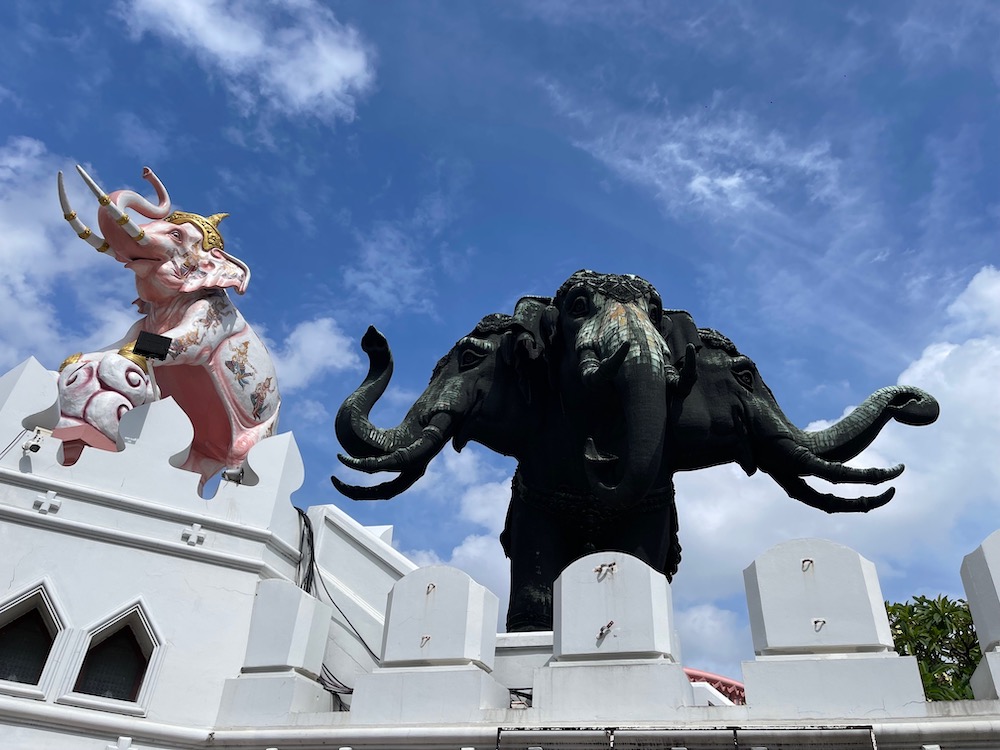The Erawan Museum is an impressive cultural gem located in Thailand’s Samut Prakan province, just a short drive from the bustling metropolis of Bangkok. For those visiting Bangkok and wanting to make a detour to this fascinating museum, getting there is relatively easy. The Erawan Museum is a landmark on the old Sukhumvit Road on the route leading from Bangkok to Samut Prakan.
How to get to the Erawan Museum in Bangkok?
The museum is located on the Bang Phli Suk Sawat Expressway overpass above Sukhumvit Road, about five kilometres south of Bearing BTS station. Although Samut Prakan is a separate province in the south of Bangkok, it still feels as if you are in Bangkok. Depending on the means of transport and traffic situation, the journey to the museum from downtown Bangkok takes 30 to 40 minutes.
The Erawan Museum is easily accessible by various modes of transport, including taxis, the Bangkok Mass Transit System (BTS) and the Mass Rapid Transit (MRT) systems. Here are the options:
- Taxi: The easiest and most convenient option is to take a taxi. It is easy to find a taxi in Bangkok. Insist that the driver switches on the taximeter.
- BTS Skytrain: You can take the BTS Skytrain to the station ‘Bearing’, which is on the Sukhumvit Line. From there, you can take a taxi to get to the Erawan Museum. Bearing station is about 5 kilometres from the museum.
- MRT Subway: You can use the MRT station ‘MRT Samrong’ on the Samrong Line. From there, you can also take a taxi to get to the Erawan Museum. The MRT Samrong station is about 3 kilometres from the museum.
- Using Grab or Bolt to get around in and around Bangkok is also an easy and convenient choice.
The Erawan Museum in Bangkok
Even in the midst of modern world architecture, the Erawan Museum is a true architectural masterpiece that captivates the senses and stimulates the imagination. This extraordinary building is not just a museum, but an impressive work of art that combines the history, culture and mythology of Thailand in a fascinating symbiosis.
Let’s dive in and explore this unique architectural jewel…

The museum is known for its striking depiction of a three-headed elephant called Erawan, which plays an important role in Thai mythology.
This huge, three-headed elephant on a domed structure with ornate details, surrounded by a white wall that looks more like the ramparts of a fort, can be seen from afar. This unusual structure is the brainchild of Lek Viriyapant, who had the vision of preserving his personal collection of Thai Art for posterity. He pursued this goal by preserving Buddhist and other relics in the country to promote cultural tourism.
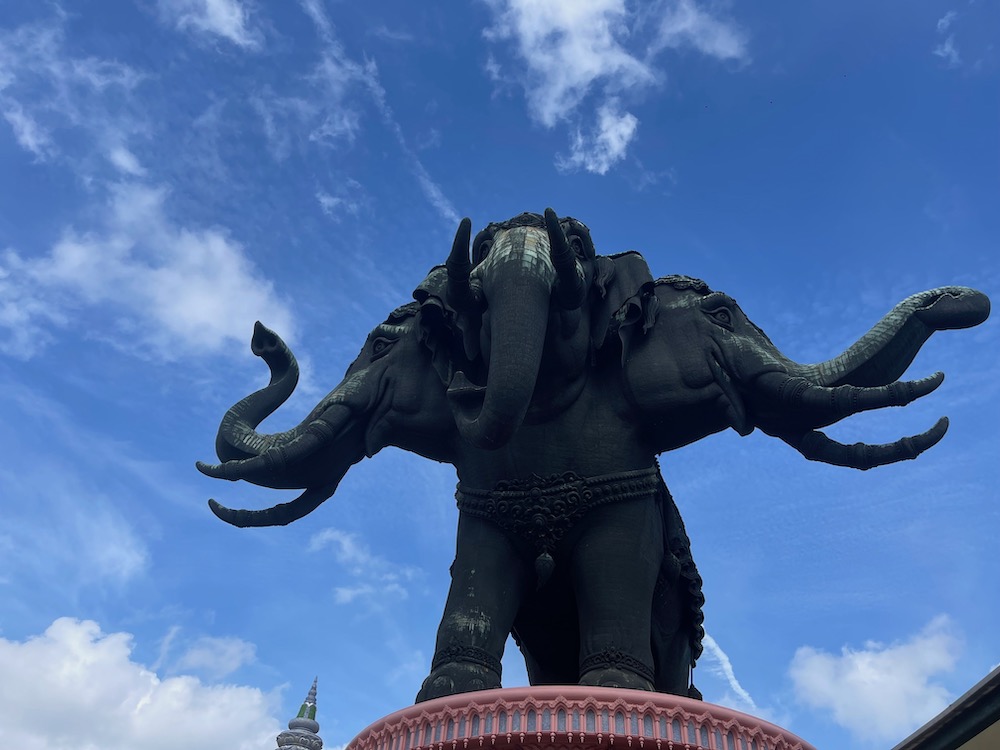
Construction of the Erawan Museum began in 1994 and it has been open to the public since 2003.
The Thai businessman Lek Viriyaphant founded and financed the Erawan Museum. Lek Viriyaphant was a well-known entrepreneur and art collector in Thailand who was committed to promoting Thai Culture and Art. He was also the founder of the Ancient City Museum (Mueang Boran) in Samut Prakan, which houses an extensive collection of replica historical and cultural sites of Thailand.
The three-headed elephant Erawan, known as Airavata in Thailand, is the celestial mount of the god Indra in Hindu mythology. This figure symbolises power, strength and royal splendour. A monumental statue of this mythical elephant was created in the Erawan Museum. The total height of the building including the elephant is 43.6 metres, the width of the elephant alone is 12 metres and its length is 39 metres. It has a weight of 150 tonnes.
The Thais believe that the Erawan has 33 heads. For practical reasons and for the sake of simplicity, the statues of Erawan in Thailand are generally depicted with three heads.
However, the striking feature of the Erawan Museum is not only the imposing statue itself, but also the unique building that houses it. The museum is housed in a circular building that can be accessed on three levels. Each of these levels represents a different world view and a different level of heaven.
The three worlds of the Erawan Museum
The Erawan Museum is divided into three levels. The idea comes from a book by Bhumitha, which says that the universe is divided into three realms, namely the underworld, the human earth and the sky. The lowest level of the museum is called the underworld, the second level is the human earth, while the third level, which is inside the elephant’s body, is heaven.
The underworld
The Underworld, also known as the Suvarnabhumi Level, is logically located in the basement of the Erawan Museum and houses a beautiful collection of Chinese vases from the Ming and Qing dynasties, the famous Sangkhalok pottery from Sukhothai, Benjarong pottery and Chakri tea sets. Other antiques include old chairs and cabinets from the early Rattanakosin period and a Khmer-style Shiva statue from the Angkor Wat period.

The human earth
The human earth section is the circular base that supports the weight of the elephant. The interior of the building contains many of the world’s art forms, including Western and Eastern art in a truly unique form.
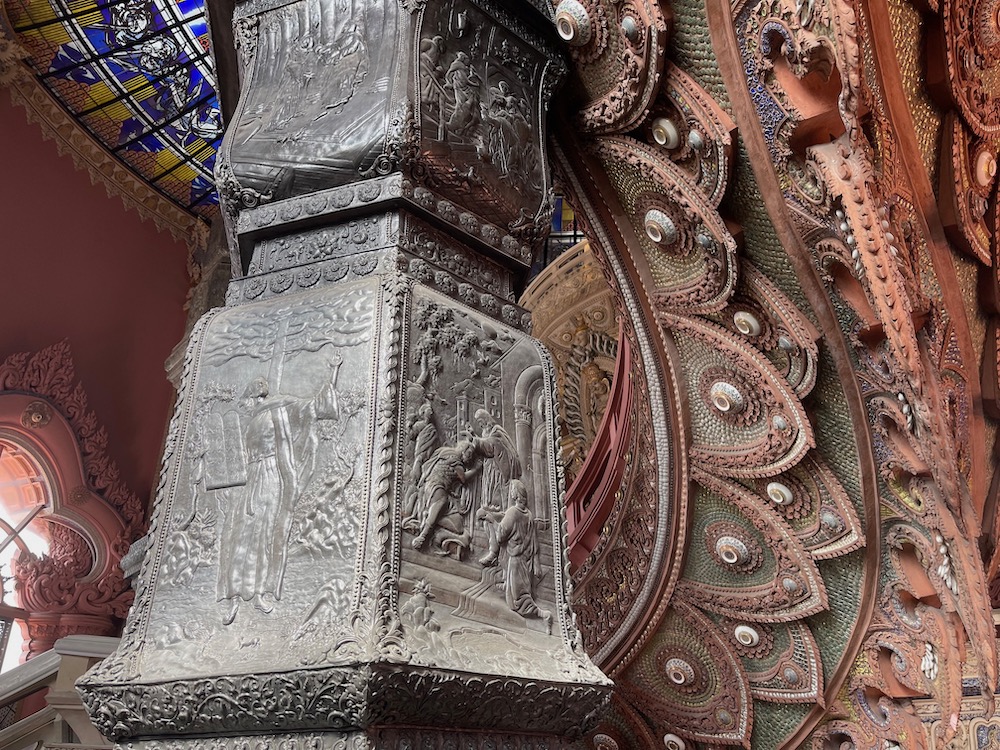
A fascinating column representing the Christian world. It is skilfully designed and shows the cultural diversity and intercultural richness that can be experienced in the museum. The four columns were decorated in an octagonal style and clad in pewter. The pewter used is covered with a beautiful and intricate pattern representing the four pillars of religion: Mercy, Kindness, Compassion and Contentment. These are the four pillars of most religions in the world. Each pillar tells a story of a religion.
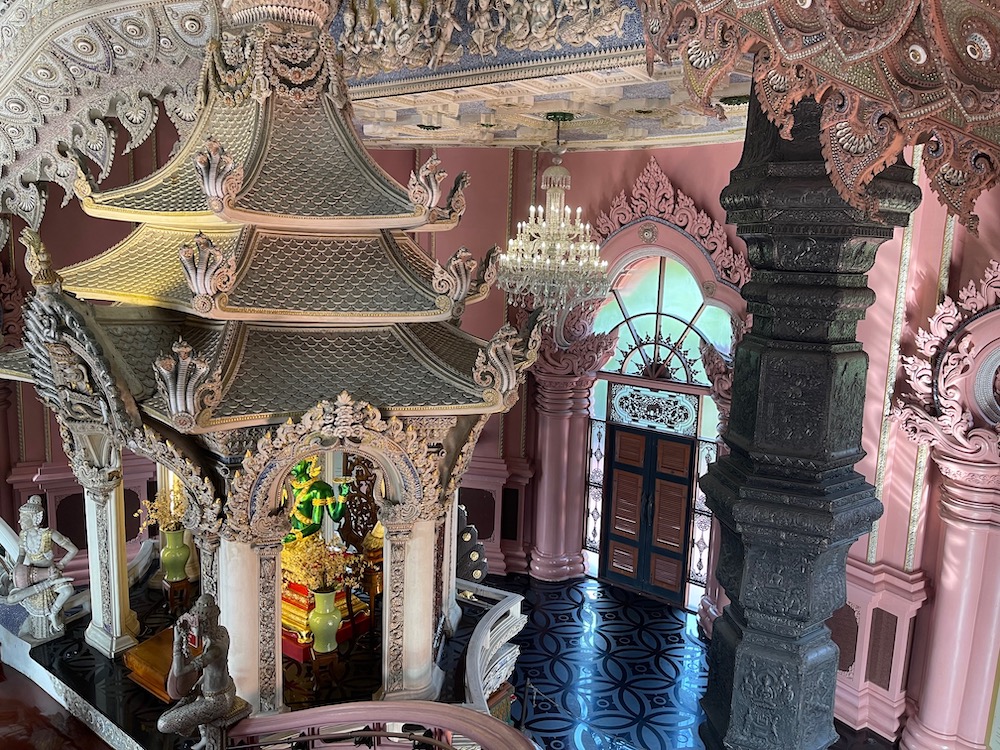
The stairway to heaven
The marvellously designed staircase in the museum leads visitors to heaven. This magnificent staircase is not only a functional element of the architecture, but also an aesthetic masterpiece. The staircase branches into two separate staircases and leads upwards on both sides of the hall. It is like the stairway to heaven, passing the altar of Kuan Yin, the goddess of mercy, on the way up. One staircase is white and the other is pink.
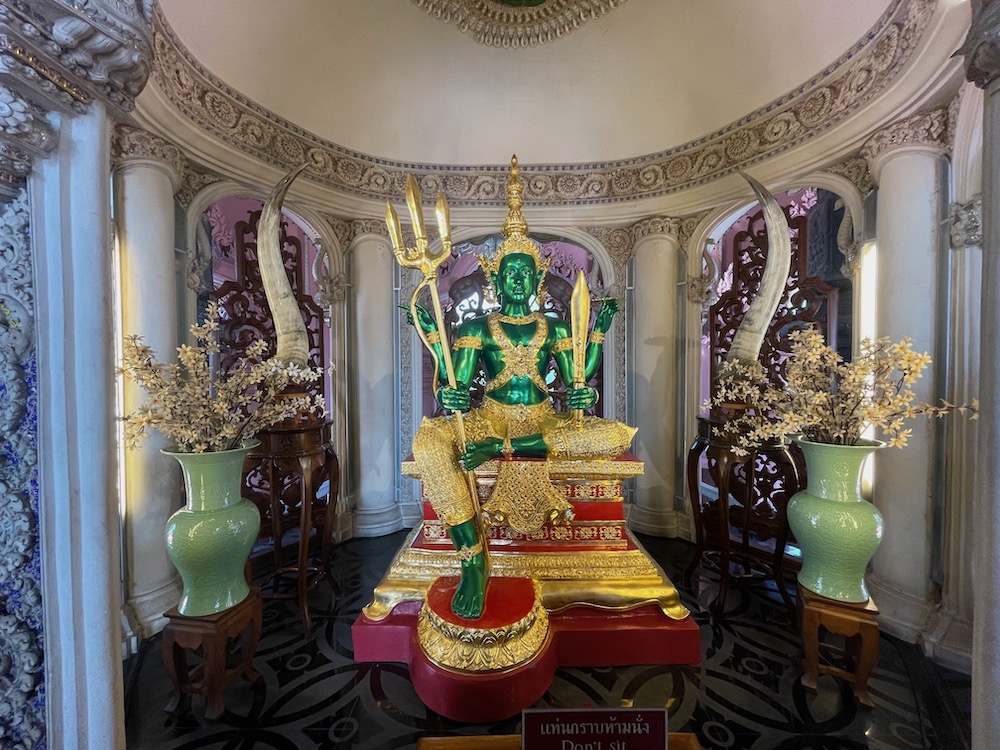
The white staircase represents purity and spiritual enlightenment. In many cultures, white colour stands for purity, clarity and spiritual purification. Walking up this staircase could symbolise that visitors are embarking on a spiritual journey in which they are striving for inner enlightenment.
The pink staircase, on the other hand, symbolises love, compassion and humanity. Pink is a warm and inviting colour that is often associated with matters of the heart and emotional depth. Climbing this staircase could mean that visitors are embarking on a journey of love and compassion, whether for themselves or for others.
High above the main hall, the glass ceiling under the dome is decorated with a map of the world, the stars and the signs of the zodiac. The ceiling was decorated with colourful recycled materials. These environmentally friendly materials, including recycled glass bottles, were truly ahead of their time. Another outstanding feature of this building are the four pillars that support the weight of the elephant’s feet.

Despite all efforts, photos can only convey a fraction of the true beauty and fascination of the Erawan Museum. This place is so overwhelming that it eludes the full capture of the iPhone camera.
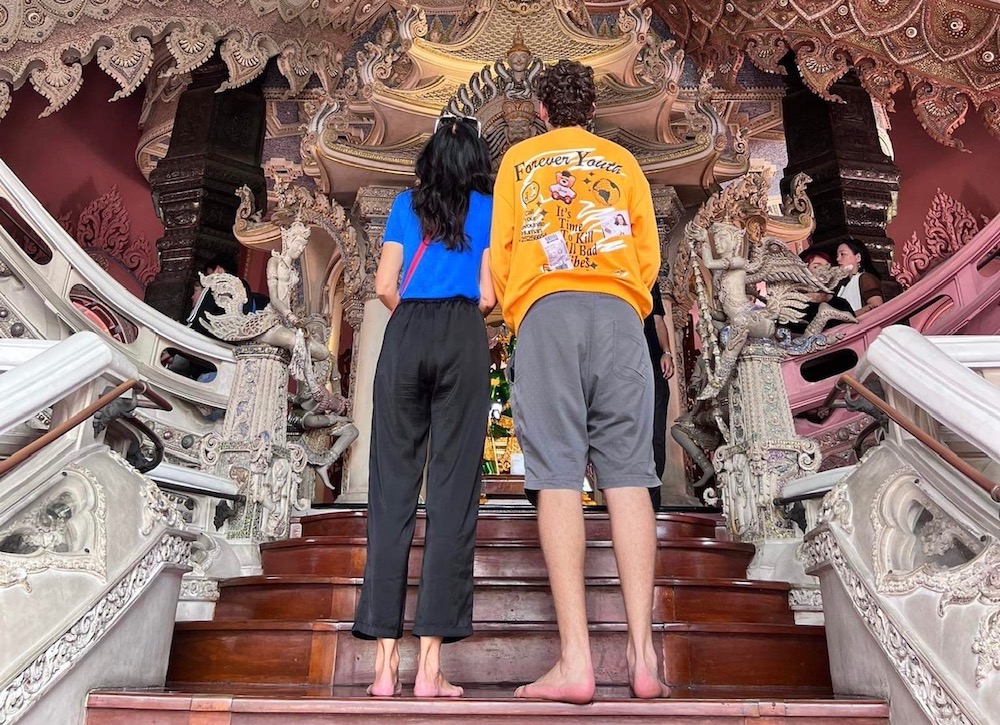
Heaven
When you step out of the lift on the third floor of the Erawan Museum, you are overcome by a sublime feeling, as if you have actually just arrived in heaven. The moment is like a magical transition from the human world into a spiritual realm filled with extraordinary beauty and tranquillity.
The depiction of the universe by a German artist in the Erawan Museum is simply overwhelming. It’s as if you are immersed in the depths of the cosmos as you look up at this ceiling, which is criss-crossed with dark depths and twinkling stars. The idea of being in outer space while actually standing in a museum is marvellous. Your mind wanders and you feel connected to the universe, as if you are looking into infinity.
The masterpiece was created by Mr Jacob Schwarzkopf, a famous German artist. This artwork is unique and uses only 4 colours to represent the essence of the earth. The colour yellow stands for the earth, the colour white for the wind, the colour red for the fire and the colour blue for the water. The outer layer shows the painting of the zodiac and the 12 most important stars. There are also images of people on earth. The entire work of art is intended to convey the effect of the stars on people’s lives.
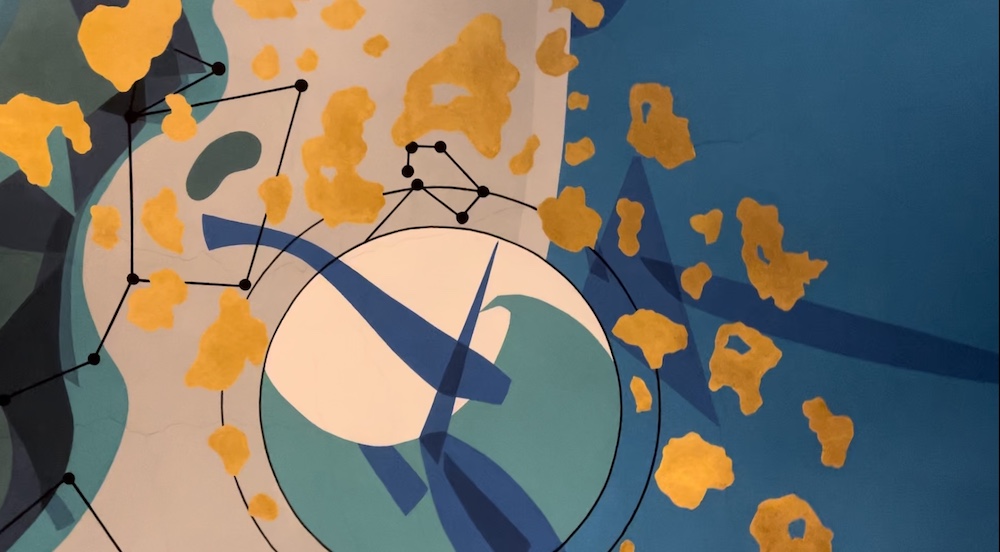
The Milky Way and asteroids are there to show us that we are just a small speck of dust in the vast universe. The atmosphere inside the universe level is calm and the lighting has been planned to give visitors space for contemplation. Buddha’s footprint can be seen in the centre of the room. The collection of sculptures and statues from times long past reinforces this feeling of timelessness. Standing there, surrounded by art and culture, you feel at one with the history and spirituality of Thailand. A moment in which you realise the beauty of the world and the deep significance of its cultural heritage.
The Erawan Museum was created as a place to honour Thai mythology and culture and make it accessible to the public. The idea of creating this statue and placing it in an impressive circular building was Lek Viriyaphant’s vision to convey the spiritual and cultural significance of Thailand. Although Lek Viriyaphant passed away in 2000, his legacy lives on through the Erawan Museum and other cultural projects he initiated. The museum attracts visitors from all over the world who want to experience the rich history, art and spirituality of Thailand.
The Parc
The wonderful park surrounding the Erawan Museum is a place of tranquillity. It offers visitors a harmonious environment in which to enjoy the beauty of nature. Seating is available in the park. The mythical figures bring Thai mythology and culture to life and give the park a magical atmosphere.
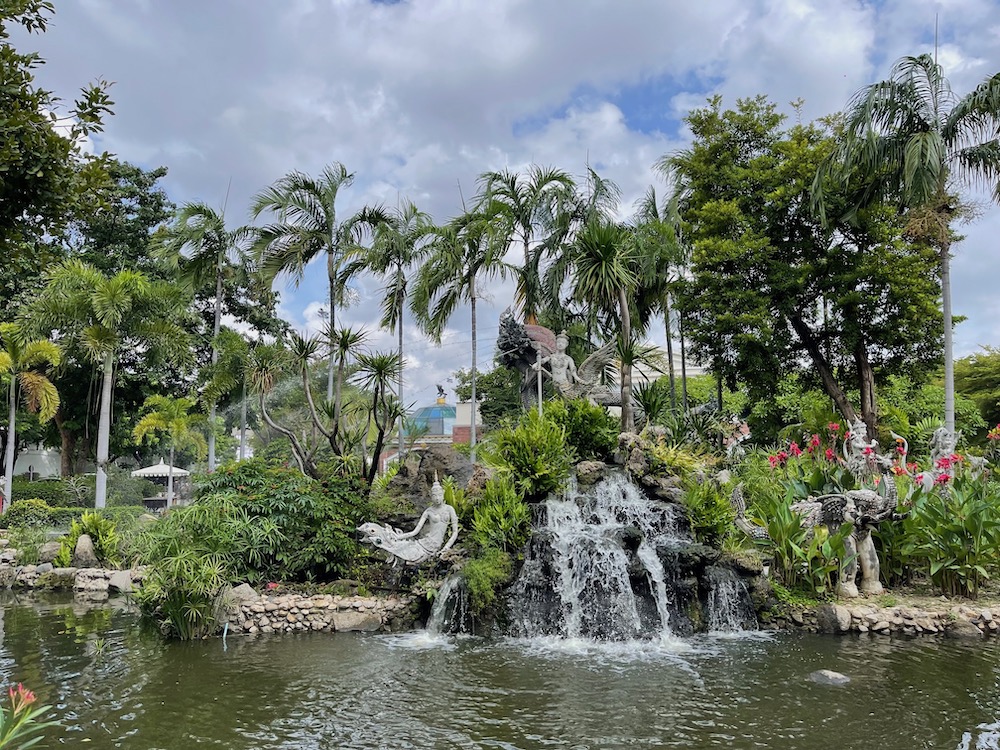
In the centre of the park is a picturesque pond surrounded by lush greenery. The fountains in the museum’s park are not only a visual delight, but also an acoustic enrichment. The many elephant statues are another interesting part of the park surrounding the museum. These statues are not only silent witnesses to Thai culture, but they also have an interactive dimension. When you walk under them, you can hear the sounds that elephants make in nature. It is as if the statues come to life and imitate the typical sounds of elephants.
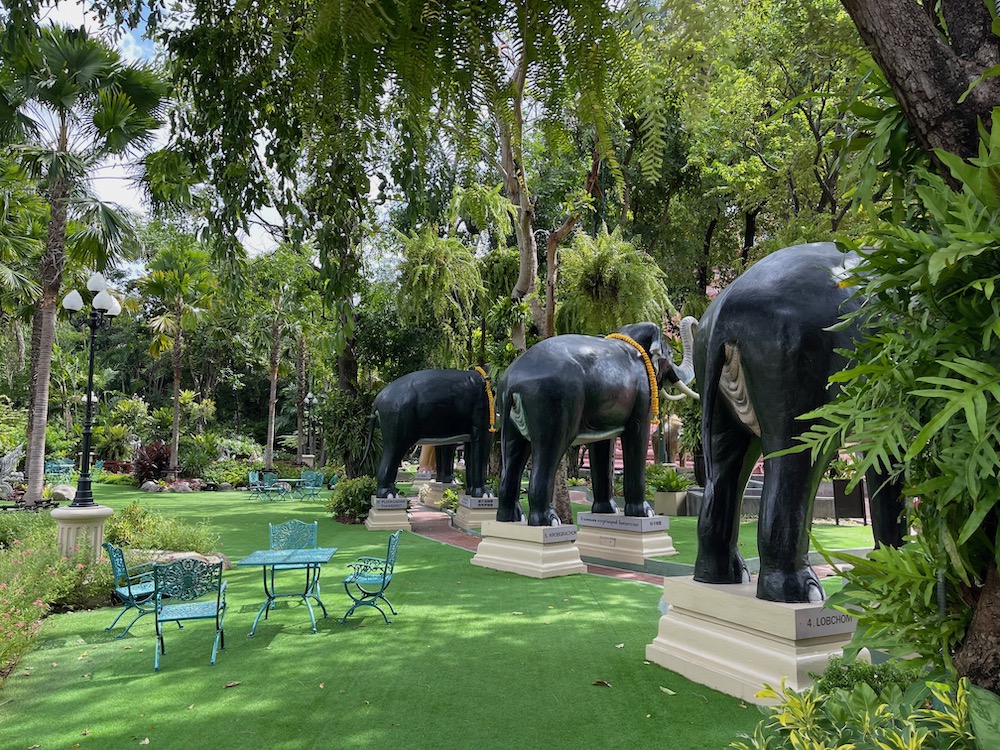
For those seeking spiritual counselling, there is an altar in the middle of the park. This place is a major attraction for worshippers who come to pray, light incense sticks and lay flowers as offerings. The altar is a symbol of spirituality and a link to Thai culture and mythology.
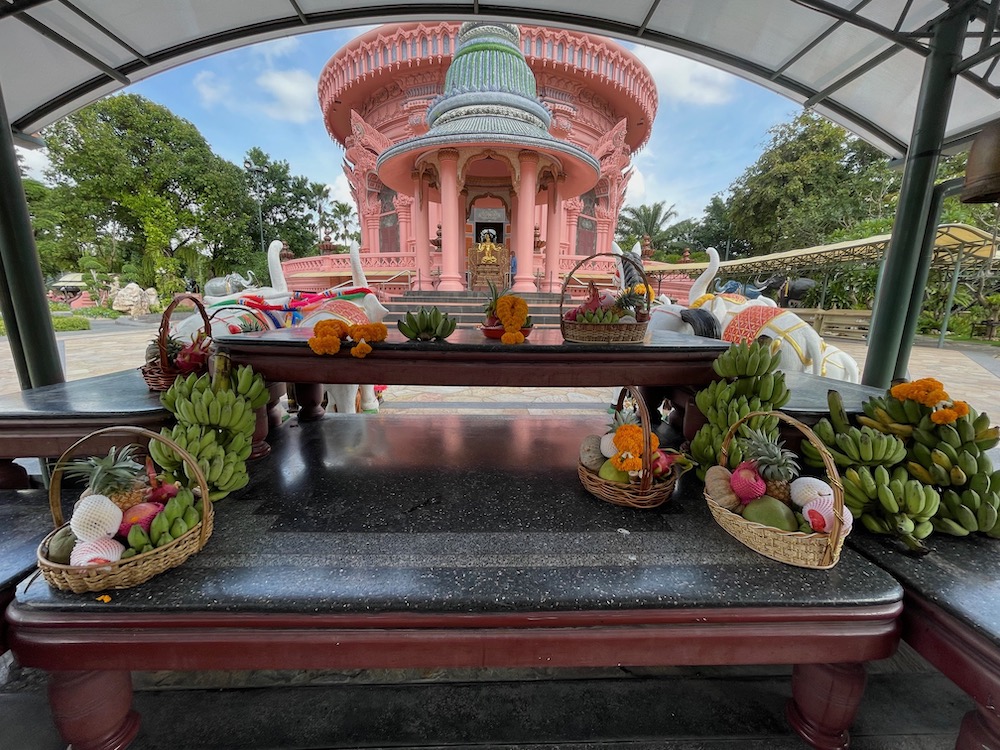
As already mentioned, Khun Lek, the founder of the Erawan Museum, was also the founder of Mueang Boran Park. (Ancient City Museum)
The Ancient City Museum is a large-scale park that houses a comprehensive collection of replica historical and cultural sites of Thailand. It pays homage to Thailand’s rich history and cultural heritage and offers visitors the opportunity to explore the country’s heritage on a journey through time. Both facilities, the Erawan Museum and the Ancient City Museum, are important cultural symbols in Thailand and reflect Lek Viriyaphant’s commitment to the preservation and promotion of Thai culture and art. They offer visitors the opportunity to immerse themselves in Thailand’s fascinating history.
Insider’ tip
In Thailand, it is common for there to be different admission prices for ‘farangs’ (an informal term for foreigners) and Thais. This practice, known as ‘dual pricing’, is widespread at many tourist attractions and facilities in the country. It is based on the principle that Thais usually pay lower entrance fees than foreigners, as it is assumed that they generally have a lower income. In fact, it is important to remember that the concept of dual pricing occurs in many countries, especially in popular tourist destinations. It can help keep costs low for local tourists while supporting the tourism sector. Travellers should inform themselves in advance about the applicable entrance fees to avoid misunderstandings and enjoy their stay in Thailand smoothly. Each destination has its own customs and practices, and it is helpful to respect and accept these to ensure a positive travelling experience.
If you live in Thailand and have a Thai driving licence or the Pink ID card, for example, you may be lucky enough to get the ‘Thai price’. This is a concession granted to people who can prove that they live in Thailand. However, it is important to note that the requirements for receiving the Thai Prize can vary depending on the location and attraction. Speaking Thai, even if it is only ‘nid noi’ (a little), is proven time and time again to be beneficial in many ways when visiting or living in Thailand. Thais really appreciate it when foreigners make the effort to learn their language, even if it’s just a few basic words. It can open doors to friendlier interactions and encounters with locals and build a positive relationship.
Conclusion
We absolutely recommend visiting the Erawan Museum. The moment you spot the giant three-headed elephant statue, you know you’re in for something truly special. Inside, the museum feels like stepping into a different world—each floor filled with beautiful art and intricate details. The stained glass ceiling casts a warm glow, and the exhibits, rich in Thai culture and spirituality, give you a deeper appreciation of Thailand’s history and beliefs. Outside, the lush gardens feel like a hidden sanctuary, with sculptures and ponds that add to the peaceful vibe.
Tickets for the Erawan Museum can be purchased directly at the ticket office on site or via various booking platforms.
Opening hours: 9 a.m. to 6 p.m., entrance fee 400 THB.
Please dress appropriately, no sleeveless clothing and no skirts or trousers shorter than the knee. Food and drink are not permitted in the Erawan Museum, but are permitted in the park.
